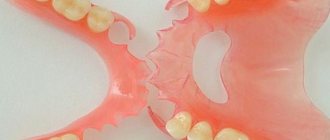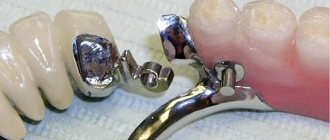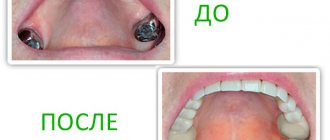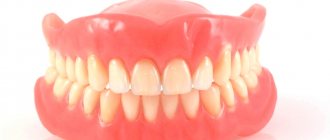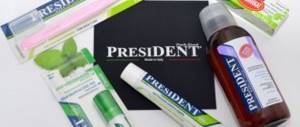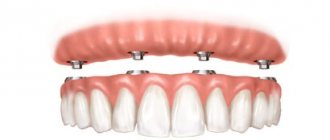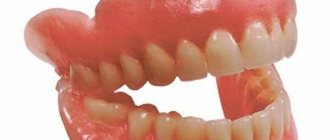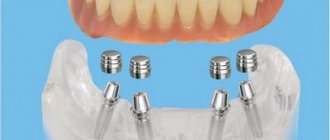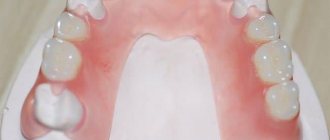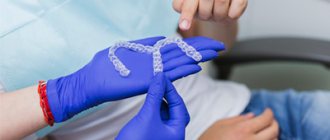The loss of even one tooth in a row can lead to serious negative consequences for the health of the oral cavity as a whole, so it is necessary to solve the problem and restore lost dental units immediately. To restore lost teeth, modern dentistry offers different types of procedures - prosthetics and implantation. The greatest demand among patients is for more affordable prosthetics, which can involve both fixed and removable types of dentures.
In terms of durability and strength of fixation, the best option would be fixed dentures, but their installation is not always possible, and then removable dentures can help restore the beauty of your smile. However, such orthodontic structures are available in a wide range, and sometimes the patient finds it difficult to choose a specific type of product for prosthetics. This article is designed to help you find out all the useful details about removable dentures, and we will start with a detailed overview of all existing types of removable dentures.
Review of the most recognizable acrylic prostheses - what they are, who they are suitable for and how much they cost
Article navigation
- What is an acrylic prosthesis
- Indications for installation
- How the structures are arranged
- Manufacturing and installation stages
- Varieties
- Advantages and disadvantages
- Can allergies occur?
- Alternatives
- Choosing between acrylic and nylon
- Service life and care
- Adaptation
- The appearance of defects and their repair
- Is it possible to repair the structure yourself?
- Cost of structures
Question for a specialist
Acrylic dentures are one of the most popular orthopedic structures for restoring several or all teeth in the oral cavity.
They have been used in dentistry for decades and are the most recognizable among patients. Next, we will tell you what an acrylic denture is, what it looks like, in what cases it is recommended and how much it costs.
The essence of prosthetics with acrylic material
Let's look at what acrylic prostheses are and in what cases they are used.
Acrylic structures are very popular due to their low price. In addition, they are used for any age category.
Removable dentures are also made from acrylic, both completely and partially. In this way, entire rows of lost teeth in any jaw can be restored.
The material of the acrylic product is a chemically produced composite that replaced the rubber previously used for prosthetics. Acrylic is much lighter, simpler and more comfortable to wear. It can be used to make a prosthesis that matches the color of living teeth and gums as closely as possible.
Acrylic products are placed on both adults and children (for example, in order to form a correct bite when baby teeth fall out unevenly).
Acrylic structures are also used as temporary structures. This way, the oral cavity is restored more quickly after treatment of teeth and mucous membranes, removal of a dental organ, filling of canals, and so on. The temporary plastic prosthesis is then replaced with a permanent one made of a different material.
Due to its low cost, this type of prosthesis is loved by older people. Many pensioners choose them to restore their teeth and their functionality.
What is an acrylic prosthesis
Plastic, plate (and plate) are all synonymous with acrylic dentures. They are made of acrylic plastic and can be attached to gums, supporting teeth and implants - i.e. The scope of their application is quite wide. The main reason for this demand lies in the properties of the material - acrylic for dentures is durable, easy to repair and inexpensive. A full acrylic denture is rigid enough to adhere well to the gums, but still slightly elastic so as not to provoke injury to the mucous membranes.
On a note! Today, some clinics offer new generation acrylic - with the addition of diamond chips.
It is softer and more aesthetically pleasing, and the finished structure fits more tightly to the gums. The prosthesis itself turns out to be less massive and does not cause as much inconvenience as a regular plate one.
The latest development - Vertex
Not long ago, the semi-rigid Vertex design was developed, which has already received many positive reviews. The following features can be highlighted:
- The material is characterized by high density and exceptional smoothness.
- The chewing load is evenly distributed on the upper and lower jaws of the product.
- The design is resistant to temperature changes and retains its shape even when eating very hot food.
- The prosthesis does not change color and does not absorb any odors.
- The product does not emit harmful substances and does not contain monomers.
- The models are very resistant to mechanical damage.
Acrylic Partially removable Partially removable Telescopic and on implants
The main competitors of acrylic are nylon dentures. The latter are considered more advanced, and here's why:
- they have an elastic, soft frame that fits better to the palate;
- due to plasticity, the risk of breakage and deformation is reduced;
- do not absorb odors;
- non-toxic, hypoallergenic.
However, there is one significant drawback: a nylon prosthesis costs 2 times more. If you want to save on prosthetics, order a plastic prosthesis. If comfort and quality are more important, then nylon is better.
Nylon prosthesis
Indications for installation
- absence of several teeth in the oral cavity (partial adentia),
- absence of all teeth in the oral cavity (complete edentia).
Complex on 4 OSSTEM implants with delayed loading - 150,000 rubles.
Complex implantation Osstem (South Korea) with delayed loading after 4-6 months.
Doctor's work guarantee - up to 5 years (under an agreement on the provision of medical services) Call now or order a call
Opening hours: 24 hours a day - seven days a week
How do orthopedic structures made of acrylic work?
Modern lamellar (covering) prostheses have noticeably changed their appearance compared to similar designs that were used ten years ago. If products of the past were created exclusively from hard plastics, today soft materials are increasingly being introduced into circulation, which make prostheses more comfortable to use and aesthetically pleasing. It became possible to use a wider color palette so that the prosthesis best suits the patient’s needs.
Plate dentures consist of a solid base (most often acrylic) and artificial teeth (usually plastic, less often ceramic). In the case of partial absence of teeth, hooks (clasps) are also an integral part of the covering prosthesis, with which the prosthesis clings to the supporting teeth. They are also made of acrylic, but sometimes they can be made of metal for better fixation.
The production of acrylic dentures takes place in a dental laboratory, and each type uses its own technology and special equipment to create. In some cases, a metal frame is included in the acrylic base.
Advantages and disadvantages
If you believe the reviews about acrylic removable dentures, then such designs have many advantages. These include:
- Minimal contraindications compared to other prosthetic methods.
- Natural appearance of the structure.
- Easy to use. The model can be easily removed and put on.
- The product is produced quite quickly. Sometimes production and installation can be completed in as little as one day.
- Easy to care for.
- Even distribution of the load when chewing.
- Durability and reliability.
- The ability to quickly repair the product in case of breakdown.
- Lightness of design.
- Affordable price.
- If necessary, such a prosthesis can be made even for a child.
However, any product has not only pros, but also cons. Acrylic dentures are no exception. Their disadvantages include the following factors:
- Due to the fact that the material is quite hard and puts pressure on the soft tissues of the oral cavity, the gums can be damaged. A similar nuisance can happen in the first 14 days, since at this time one is getting used to a foreign object.
- If there are real supporting chewing units or crowns under the denture, they may begin to wear off when rubbing against the artificial jaw.
- When worn for a long time, acrylic begins to release harmful substances. Although toxins appear in small quantities, allergies or even toxic poisoning are still possible.
- The prosthesis material has a porous structure, so bacteria can form on it. In the absence of high-quality hygiene, this will lead to the occurrence of inflammatory processes. Bacteria also causes an unpleasant odor.
- If the product is fixed only due to the suction effect, then sometimes it can jump off, which causes discomfort during use.
Manufacturing and installation stages
- dental diagnosis of the patient, selection of the optimal orthopedic design,
- preparation of the oral cavity for prosthetics: sanitation – treatment of caries and cleaning of plaque/tartar,
- taking impressions of the jaws: if surgical procedures were performed before prosthetics (for example, tooth extraction), it is recommended to wait until the soft tissues have healed before taking the impression, so that the fit of the base is subsequently more dense and accurate,
- making a model in a dental laboratory,
- fitting the model to the patient: there may be several fittings until all the shortcomings are eliminated,
- production of the prosthesis itself, its grinding and polishing,
- The orthopedist tries on the structure in the patient’s mouth and, if necessary, adjusts it until it is “victory” - that is, until the bite is restored, until the patient becomes as comfortable as possible.
Preparation for prosthetics
Before installing removable dentures, it is necessary to clean the oral cavity of hard dental deposits (tartar) and remove carious lesions - these are dangerous sources of infection. Our dentist-therapist will first carry out professional teeth cleaning and cure caries.
If the prosthesis is installed on abutment teeth, their preliminary preparation may be necessary: the doctor will remove the pulp (nerve) and process the tooth so that the orthopedic structure can be fixed to it.
Make an appointment with a dentist at the Lucky Smile clinic. The doctor will examine you and recommend the most suitable solution for your clinical case and budget.
What varieties exist
They are removable and conditionally removable. The patient himself removes the removable structures from the mouth after each meal, rinses, cleans and fixes them back. But conditionally removable ones are almost constantly in the mouth and do not require them to be taken out often - standard hygiene, as with your own teeth, is enough. Specifically, acrylic ones are most common as removable ones, but conditionally removable options are also found.
Removable full covers
- When to use: with complete edentia.
It is precisely these designs that evoke the first association with the “false jaws” that our grandparents dipped into a glass of water at night. Previously, this was really required and was explained by the characteristics of the materials. Today, acrylic removable dentures that replace the entire jaw do not need to be immersed in water; they can be worn continuously throughout the day. Their design does not contain any metal fasteners, and they are held in place by a secure fit to the gums.
On the upper jaw, a completely removable acrylic prosthesis, replacing the entire dentition, turns out to be quite massive, since it covers the entire palate - there are quite a lot of different cavities on it, so the base is glued to both the gums and the palate. For better fixation, it is possible to use special creams and adhesives. But when choosing acrylic of the latest generation, the palatal bridge can often be made less massive.
In the lower jaw, the prosthesis rests solely on the gums; it is less massive, so mobility may occur when the use of various fixing agents is also required.
They cannot be called too comfortable - the massive and hard gum base made of plastic creates the feeling of a foreign body and causes discomfort. However, it is these acrylic orthopedic structures that are most often chosen by patients with limited financial resources, as well as in situations where other prostheses cannot be installed.
Removable partials
- When to use: for partial edentia.
Serve to restore several lost teeth. In the upper jaw, an artificial palate is again used to better secure the acrylic partial denture. To ensure stability, fixation is also carried out to the supporting teeth - for this purpose, metal or plastic hooks are provided on the base. Prosthetics with acrylic structures for partially missing teeth are very affordable, but are not effective enough in terms of comfort, aesthetics and degree of fixation in comparison with bridge prosthetics and dental implantation.
Removable immediate prosthesis (“butterfly”)
- When to use: in the absence of 1-2 teeth.
“Butterfly” is the smallest orthopedic structure made of acrylic. There are also white crowns, a pink plastic base and the same hooks that are attached to the adjacent remaining teeth. Immediate dentures quickly fail, stretch, and lose their shape. Therefore, they are recommended only on a temporary basis - for example, while a stronger and more durable structure is being made, or while implants are taking root.
Conditionally removable or non-removable with support on implants
- When to use: with complete (or almost complete) edentia.
If classic removable dentures cause serious discomfort to the patient - they constantly move and put pressure on the gums, then you can also consider the option of conditionally removable prosthetics on implants. And sometimes even permanent prosthetics. When fixed to implants, very high stability of the prosthesis is achieved, and there is no need for additional gluing to the cream. The disadvantage of this type of prosthetics is that it is several times more expensive than classic ones.
To secure a conditionally removable structure, abutments are first attached to the implants from the top in the form of small balls or “equator” type. And inside the prosthesis, matrices are installed that snap onto the abutments. Or a metal beam is placed on the implants, onto which the acrylic base of the prosthesis will then be attached. A person can remove a conditionally removable structure independently, but often this is not necessary, because fastenings will loosen or wear out faster.
A fixed acrylic prosthesis has a metal beam inside that stabilizes the installed implants (for example, with a protocol for restoring all teeth on 4-6 implants or when choosing a zygomatic, basal technique). Such a prosthesis is attached to a permanent base using a screw or cement fastening.
Implants have become very popular in recent years. Because they ideally replace the roots of natural teeth and provide the best support for dentures that do not wobble and feel like natural teeth. Implants also prevent bone atrophy, which begins after tooth roots are removed. If a person chooses classic removable solutions based on the gums, he should be aware that the level of bone and gums will constantly decrease. Therefore, the removable one will soon become uncomfortable, and you will have to go to the dentist to adjust it - and so on every few months.
Is it possible to repair a prosthesis at home?
An acrylic denture accidentally dropped into a sink or on the floor may crack or break. This can also happen when certain areas are under heavy load during chewing.
The patient can repair a removable denture on his own, but not always. Breakage of the clasp (attached hook) cannot be done by a person without special skills, so in such a situation you need to contact a specialist.
Some patients try to glue a broken prosthesis with conventional adhesives (Moment, PVA, epoxy glue), which is strictly prohibited. After all, such compositions may contain toxic substances that are harmful to the human body and can lead to dermatitis or eczema.
When deciding to repair a prosthesis yourself, it is important to know the following:
- If you glue a structure with PVA, moisture can lead to its softening and rapid divergence of the seam.
- A rubber prosthesis is also not suitable for an acrylic prosthesis. The glue seam should not be elastic, but rather its rigidity is important. If a nylon prosthesis is glued together, the situation is the opposite.
- Using a large amount of hardener relative to the epoxy resin runs the risk of severe irritation of soft tissues from the alkaline amines contained in the hardener.
- Cyanoacrylate super glue can sometimes be used to temporarily repair acrylic dentures. It is advisable to use it when the patient has already made an appointment with a specialist for repair of the structure, but the day of the appointment will come in a few days, during which the patient does not want to go without teeth. In such a situation, super glue is the safest option relative to other types of glue. It is important to carry out gluing as carefully as possible. But the glue seam will also not last long, since it will constantly be in contact with moisture.
There are patients who tried to repair the structure by soldering it. Usually such manipulations are unsuccessful, regardless of whether the patient used polymethyl methacrylate for this.
If the clasp fits very tightly, or vice versa, too loosely, it is also better to entrust the correction of the prosthesis to a specialist. For the bravest patients who decide to do it themselves, it is recommended to use pliers for this. In this case, great caution and constant testing of the structure are important so as not to provoke the hook to break off.
The same applies if you want to avoid chafing. Some patients try to sand the surface of the base using sandpaper or a nail file.
If you are not sure that you will do it well, you should not do it. After all, you can ruin your prosthesis by trying to improve it at home. Repair and correction of a prosthesis is a matter for a specialist.
Pros and cons of acrylic structures
Plate dentures are the most inexpensive type of removable dental prosthetics. Other advantages of acrylic include the ability to repair damage, ease of manufacture and subsequent maintenance. If the prosthesis is made correctly, then overall it will be very comfortable. But there are still more disadvantages (as with any other type of removable denture):
- relative aesthetics: they look quite natural, all materials used are selected in shades to match the colors of the teeth and gums. But the excessive massiveness of the structures and the use of hard plastics still make them insufficiently aesthetic, and this is primarily felt by the patient himself, and not by those around him.
- discomfort: again, due to the large size of the plastic gum and palate, diction is impaired, ulcers often appear on the gums,
- poor fixation: the use of fixing creams is required,
- short service life: maximum 5 years, but usually about 3 years,
- porosity and insufficient strength of the material: they can absorb dyes and odors, and also cannot withstand heavy chewing loads.
Can allergies occur?
Gum irritation when wearing acrylic structures is a fairly common occurrence. The acrylic monomer, in contact with the tissues of the oral cavity, penetrates them and has a toxic effect, expressed in the appearance of itching, swelling, and redness. Therefore, modern acrylics made in Germany or Japan, which are less allergenic, are becoming increasingly popular in orthopedic dentistry.
Don't know what type of prosthetics to choose?
We will help in the selection, advise where to read more information and compare types of prosthetics.
Consultation with an orthopedic doctor in Moscow clinics is free! Call now or request a call
Working hours: from 9:00 to 21:00 - seven days a week
Recommendations after prosthetics
Patients who have acrylic dentures installed must visit a dentist once every six months as planned.
Patients who have acrylic dentures must visit a dentist once every six months as planned. This is to ensure that no correction is necessary.
Considering the affordable cost of this type of removable prosthetics, as well as reviews and ease of use, it is not difficult to understand why dentists and patients prefer acrylic dentures.
We invite you to a free consultation with the head doctor of the 22nd Century Professorial Dentistry.
Date of publication: September 20, 2020 Last update: September 22, 2021 © 2020 Professorial Dentistry “22 Century”. All rights reserved.
Service life and care
How to care for acrylic dentures and how to clean them? Today there is no need to soak structures in a glass of water overnight. You just need to regularly clean artificial teeth and gums from bacteria and plaque using a regular toothbrush and toothpaste without abrasive particles.
There is nothing complicated about how to store acrylic dentures. To do this, you need to purchase a special box, which is sold at any pharmacy. It is important that the product must be placed in this box in its pure form so that it retains its original appearance and quality longer. The warranty period is usually 1-2 years, but with very good care acrylic can last 5 years.
Difference from nylon models
Many patients are interested in which dentures are better - nylon or acrylic. Indeed, these materials are very common and constantly compete with each other.
They have the following differences:
- Acrylic. It has a solid structure and holds its given shape for a long time. It has a porous composition and is susceptible to the formation of microbes. Releases toxic components during prolonged wear. Can be fixed using special glue. The main advantage of such models is the affordable prices for acrylic dentures.
- Nylon. Soft material that adapts well to the oral cavity. May become deformed over time. Structures made from it are non-porous, so there is almost no plaque or odor on them. The material does not emit toxic substances. As a rule, removable products are fixed due to the suction effect; cream may not be used. Prices for nylon prostheses are quite high.
Features of the adaptation period
Many people have difficulty getting used to it, especially if the upper jaw has been replaced with prosthetics. Nausea, lisp, increased salivation or dry mouth, and discomfort may occur. To minimize all these manifestations, orthopedic dentists recommend wearing “new teeth” for as long as possible in the first days, so adaptation will go faster. You can also massage your gums, drink water often, say tongue twisters, and avoid eating hard foods. To prevent the structure on the lower or lower jaw from falling out of the mouth, you can use fixation creams.
By mounting method
In modern dentistry, various means of fixation are used. The comfort and duration of getting used to the structure will depend on the chosen method and quality of fastening. The orthopedic surgeon selects specific methods of fixation taking into account the individual clinical situation and the chosen method of prosthetics.
Creams and powders are considered one of the more reliable means of fixing removable dentures. A special product is applied to the denture, which is then pressed tightly to the oral cavity. Creams are recommended for patients with increased salivation, and powders are used for low salivation. If the structure of the jaw is abnormal, orthopedic doctors recommend using fixing strips.
Clasp-type dentures are secured using attachments or clasps. Alveolar processes are also used, which provide additional fixation. When putting on a removable denture, reliable fastening provides a suction effect.
The appearance of defects and their repair
The most common defects that can appear in acrylic prosthetics are cracks, chips, and changes in surface shade. They arise either due to improper or very long use. In most cases, the product can be repaired, but if the defect is very large, then the design may be considered beyond repair. Many patients who have experienced a breakage worry about whether it is possible to build up a fallen acrylic tooth. Such repairs are simple, but they must be carried out by a specialist.
When is repair needed?
Urgent repair of the prosthetic system will be necessary when:
- removal of one of the remaining teeth;
- damage or loss of the crown from the base;
- clasp failure;
- weak adherence of the base to the gum;
- the appearance of chips on the frame.
The repair procedures carried out will take only a couple of days, but will ensure reliable fastening of the entire system.
Is it possible to repair the structure yourself?
When thinking about how to repair and how to glue a prosthetic structure made of acrylic, or how to solder a tooth, the best solution would be to refuse to repair it yourself. Even if you have glue on hand that “glues everything,” and a soldering iron with the thinnest tip. In order not to render the product unusable or to avoid getting burns from household glue, you need to know that repairs are made only by an orthopedic dentist or a dental technician. Only professionals have all the necessary skills, materials and equipment to ensure that the repaired product can meet its specifications.
Manufacturing process
The production of acrylic structures is characterized by maximum simplicity. The following stages of product creation can be distinguished:
- In dentistry, the patient is diagnosed with the oral cavity and assessed which prosthetic option will be most suitable.
- If necessary, treatment is carried out. You cannot install a removable structure if there are inflammations or diseases in the mouth.
- The doctor makes a cast of the jaw, which is used to create a plaster model, and then the product itself from acrylic.
- The patient tries on the model. If necessary, it is corrected.
The process of making a prosthesis takes a maximum of 7 days, but the adaptation time to it can last up to 30 days. If a person experiences discomfort, feels strong friction, or feels like the model is not made to fit, you should consult a doctor.
Cost of acrylic structures
Acrylic orthopedic structures for replacing the entire dentition are the cheapest type of prosthetics. As a rule, the cost of a complete prosthesis starts from 15 thousand rubles. A partial can be purchased for the same price, but a butterfly is usually 30-50% cheaper. Complete prosthetics of an entire row of teeth on implants starts from 150 thousand rubles.
Zirconium dioxide crown on an implant for the whole 70,000 rubles.
OSSTEM implant (South Korea), individual zirconium abutment, gum former, impression taking.
Creation of a Prettau zirconium crown using 3D modeling technology. Consultation with 2 doctors: an orthopedist and an implantologist for free! Call now or request a call
Opening hours: 24 hours a day - seven days a week
Author: Vasin Yu. A. (Thank you for your help in writing the article and the information provided)
Our clinic
This option for restoring chewing function, such as prosthetics, is very popular. Many patients leave positive reviews about removable dentures made of acrylic plastic.
I have been using acrylic dentures for 2 years now. At first it was very difficult to get used to, but then I no longer felt any discomfort. My artificial teeth look just like regular teeth.
Anna
A T-crystal prosthesis was installed. It was hard to get used to, I felt very nauseous. Well, what can you do if you don’t have money for implants? But after 1.5 months the discomfort disappeared, I wear a removable jaw every day. I don't even feel it.
Raisa
I was sure that acrylic dentures are worn when all the teeth fall out due to old age. I had to have two teeth removed, I thought I needed to get an implant, but I couldn’t afford it. The dentist put on a butterfly. Very comfortably. And the price is very low.
Olga

